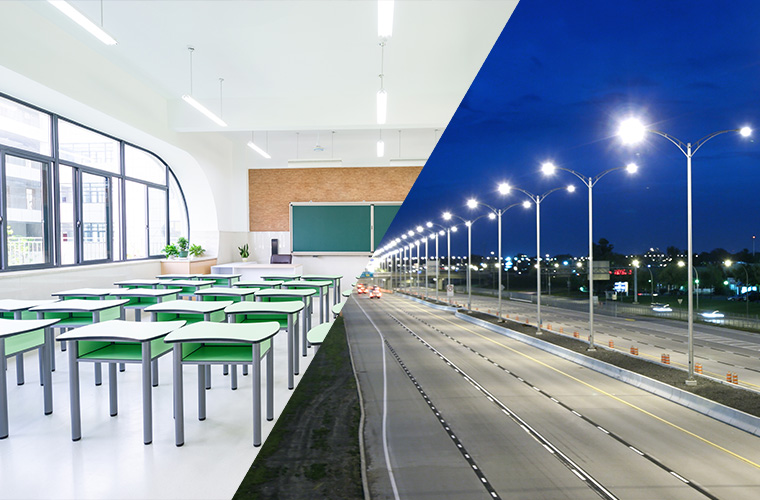From utility rebates and new ANSI standards to an increasing emphasis on human-centric lighting, manufacturers share their predictions for the Education and Outdoor/Street Lighting segments in 2019 and what distributors need to know to maximize their participation.
Will the new year bring a strong lighting market? Below, experts from Signify and LEDVANCE share their predictions for the Education and Outdoor/Street Lighting segments, external factors affecting those markets, and how distributors can tap into their share of opportunities.
2019 Forecast: Education Lighting
“Like many other sectors in the U.S., there’s a tremendous opportunity in Education around the increasing demand for more energy-efficient light,” shared Heather Milcarek, head of Professional Channel Marketing at Signify (www.signify.com/en-us). “LED adoption can not only drive energy savings, but can also reduce operational and maintenance costs, freeing up much-needed budgetary dollars that can then be reallocated to other priorities in the school, such as student achievement.”
“To help spur energy-efficient upgrades in schools, other financial incentives such as utility rebates can help further offset project costs, and in 2019 we’ll continue to see a shift in commercial rebates from lamps to luminaires and controls,” predicted Milcarek, who noted that there are currently some very lucrative incentives available for luminaires, which, in some instances, customers can obtain for little-to-no investment. “Funding continues to increase year-over-year, with an estimated $370 million expected to be available for C&I lighting and controls rebates in 2019, and advanced lighting controls are expected to receive more rebate attention in order to drive adoption.” Specifically, she said, “controls rebates are expected to witness a 20.6% CAGR over at least the next 5 years, making new innovations like ‘Interact Pro,’ an easy-to-install-and-commission connected lighting system for application, even more attractive to schools and the contractors working on these projects.”
In addition to an increasing emphasis on controls, Milcarek noted that other key trends beyond just energy savings are also taking shape in the education sector. Among those, “there’s a burgeoning opportunity around lighting systems designed to help improve productivity, engagement levels, and focus in classroom environments,” she said. “The digital nature of LEDs provides a unique opportunity to easily adjust light levels based on the task or activity taking place. With Interact Pro, for example, lighting scenes can be easily programmed using a mobile device to support a wide range of classroom activities, from testing and independent study to reading and creative thinking. And because Interact Pro can support various combinations of lamps, retrofit kits, or new fixtures,” Milcarek said, “the system is applicable to just about any space inside the school, whether it’s a classroom, library, gymnasium, or faculty lounge.”
While high-quality LED lighting is commonly understood to reduce energy and operational costs, Milcarek reiterated that the industry continues to place increased focus on how lighting can affect the way we feel and function. “This is particularly important in education settings, where lighting can play a more valuable role in supporting true learning environments,” she said. “By working with a manufacturer that not only has a comprehensive product portfolio, but also one with extensive expertise in the science of lighting,” she advised, “distributors can add consultative services that better meet the needs of their customers.”
2019 Forecast: Outdoor and Street Lighting
According to Omar Rivera, head of Luminaires in the U.S. and Canada for LEDVANCE, maker of SYLVANIA general lighting in the U.S. and Canada (www.sylvania.com/luminaires), the lighting industry has adapted the ‘ANSI 136.41’ standard for smart city photocell wireless network communications. Specifically, “this photocell socket has moved from a 3-pin to a 7-pin format to allow for two-way communication between lighting fixtures and facility wireless gateways and will allow for a collection of data that enables everything from basic outdoor lighting maintenance to more advanced purposes such as traffic monitoring and parking availability,” Rivera said.
In terms of its significance to the field, “the 7-pin socket and smart photocell will allow distributors and contractors to provide a whole new level of solutions to their customers,” Rivera said. “Before this, you had to use a line-of-sight approach in order to maintain an outdoor lighting system – e.g., somebody needed to physically see whether a light was on or off,” he explained. “This new wireless network system will allow lighting to be monitored remotely from anywhere where there’s internet service. For instance, you could be at the beach with a laptop and know what’s going with your lighting system.”
To capitalize on this technological advancement in outdoor/street lighting applications, Rivera recommends that distributors select the 7-pin socket option from the product datasheet to ensure that it will be installed at the factory level to help reduce field installation time and costs.
In addition, “it’s important to review and familiarize yourself with different smart photocell wireless systems to make sure that you’re able to provide all of the solutions, features, and benefits the customer is looking for,” Rivera said. “Having a good understanding of what the customer wants will help guide you to the proper system at the right cost.”
Tagged with education, lightED, market outlook, outdoor lighting, street lighting